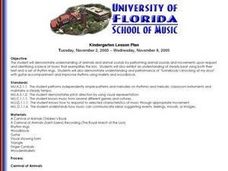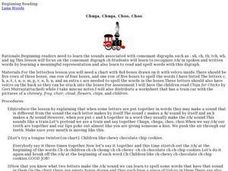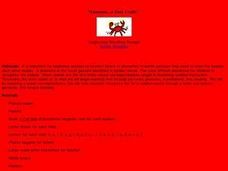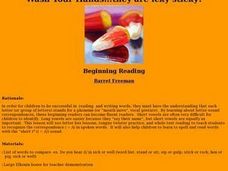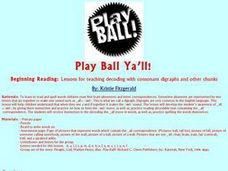Curated OER
Meet Lee, the Sleepy Bee
First graders distinguish between the different ways to create the sound for long vowel e. They are introduced to the vowel patterns that comprise long vowel sounds. They practice reading and spelling a variety of words containing the...
Curated OER
Pronunciation of Initial /s/ Consonant Clusters
Students comprehend how to produce these pronuciation features, recognize the various blends of initial /s/, hear the sounds, produce them correctly when thinking about it, and practice correct pronunciation to be comprehended by others.
Curated OER
Beginning Consonants
In this beginning consonants learning exercise, students say the sound of a letter, name pictures in the row and circle the pictures that begin with the given sound. A reference web site is given for additional activities.
Curated OER
Get to Know Your Neighbor
First graders accurately name letters with their phonetic sound. In this letter recognition lesson, 1st graders respond to a question about summer when their name letter is called. Students describe a summer experience.
Curated OER
Somebody's Knocking At My Door
Students perform animal sounds and movements, demonstrate a steady beat using both feet, and perform portions of the song "Somebody's Knocking At My Door" in this Music lesson for the Kindergarten classroom. State and National Standards...
Curated OER
What is the Beginning Sound?
In this early childhood beginning sounds worksheet, students practice their phonics skills as they look at 6 pictures, say their names, and identify the letter that begins the 6 words. An animal habitat question is also included on the...
Curated OER
Shhhhh
First graders identify the digraph /sh/ in written and spoken language. After a brief discussion of the independent and combined sounds of the phonemes /s/ and /h/ students practice identifying initial and final placement of the new...
Curated OER
Chuga Chuga Choo Choo
First graders identify the digraph /ch/ in written and spoken language. After a brief discussion of the independent and combined sounds of the phonemes /c/ and /h/ students practice identifying initial and final placement of the new...
Curated OER
Chug Choo Choo
First graders identify the digraph /ch/ in written and spoken language. After a brief discussion of the independent and combined sounds of the phonemes /c/ and /h/ students practice identifying initial and final placement of the new...
Curated OER
Don't Wake Mama
Students identify the digraph /sh/ in written and spoken language. After a brief discussion of the independent and combined sounds of the phonemes /s/ and /h/ students practice identifying initial and final placement of the new digraph...
Curated OER
Reintroduce /D/
Students study letters. In this letter identification lesson, students practice recognizing and pronouncing the letter "d." They work as a group to actively participate in various drills the teacher leads them through. This lesson...
Curated OER
Speedy, Speedy Students Reading Fast
Pupils review basic reading decoding. Given books at their independent reading level, they read independently and with several different partners to increase reading fluency. They see how many more words per minute they can read after...
Curated OER
The Plain Train sat in the Rain
Students study the ai=/A/ grapheme by reading "James and the Good Day" with a partner and discussing it. Next, they recite a tongue twister focusing on the ai=/A/ correspondence. They make words using their letterboxes and letters before...
Curated OER
Can You Open the Creaky Door?
Students recognize the short vowel e in written and spoken language. Through matching and listening activities, they discriminate the vowel sound /e/ from other phonemes. Students identify the phoneme and letter in words and pictures.
Curated OER
E-E-E-E-Extra E-E-E-E-Effort
Students listen to a tongue twister emphasizing the short e sound. They practice writing the letter e and attaching different words with that sound to it. They listen to a book about a dog that enhances the letter e. They write a...
Curated OER
Icky Sticky
Students recognize the short vowel i in written and spoken language. Through matching and listening activities, they discriminate the vowel sound /i/ from other phonemes. Students identify the phoneme and letter in pseudo words they read.
Curated OER
The Squeaky Creaky Elevator
Students engage in an emergent literacy lesson in order to help develop the skills of letter recognition and corresponding sound of the phoneme. This is done with the use of a tongue twister using the phoneme of the letter "e".
Curated OER
Iiicky, Stiicky, I
First graders recognize the short vowel i in written and spoken language. Through listening and matching activities, they discriminate the vowel sound /i/ from other phonemes. Students identify the phoneme and letter in psuedo words they...
Curated OER
Load the Boat To Travel the Moat
Learners discover that letters stand for phonemes. They determine that spellings map out the phonemes that are found in spoken words. They analyze the correspondence, oa = /O/ and recognize the /O/ sound in spoken and written words in...
Curated OER
O-o-o-oh, no-o-o-o!!
Young scholars engage in an emergent literacy lesson in order to practice the skill of phonemic awareness. They learn this skill using the phoneme for the letter "o". Students must recognize the letter as well as its sound.
Curated OER
"Aaaaaaa...a Fast Crab! "
Young scholars participate in an emergent literacy lesson plan that focuses on the skill of phonemic awareness. The phoneme chosen is the letter "a". They need to correlate the sound to the letter.
Curated OER
Wash Your Hands...they are icky sticky!
Students engage in an emergent literacy instructional activity that focuses on phonemic awareness and they practice corresponding the letter "i" to its long or short sound. This type of recognition has been found to be essential to...
Curated OER
Play Ball Ya'll!
Learners explore the /awl/ phoneme. They examine the /awl/ sound and how to make the sound themselves. They say /awl/ tongue twisters and use letterboxes to write several 'all' words. They read stories with the /awl/ sound.
Curated OER
Max's Magic Magnets
Learners identify the letter and phoneme /m/ in written and spoken language. Students practice the production of the /m/ sound through tongue twisters and stories. They identify the initial placement of the letter and sound using a...






